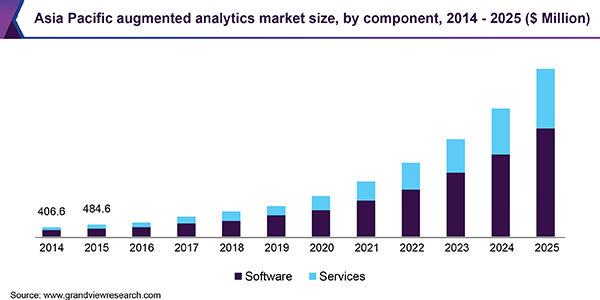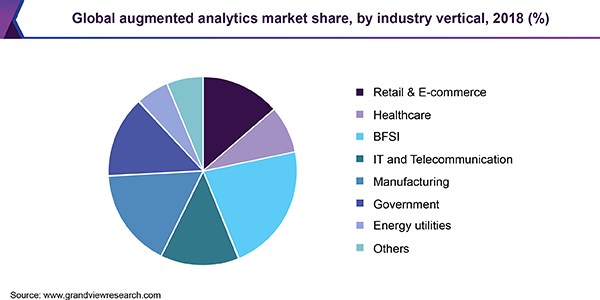- Home
- »
- Next Generation Technologies
- »
-
Global Augmented Analytics Market Size, Industry Report, 2019-2025GVR Report cover
![Augmented Analytics Market Size, Share & Trends Report]()
Augmented Analytics Market Size, Share & Trends Analysis Report By Enterprise Size, By Component (Software, Services), By Deployment Type, By Industry Vertical, By Region And Segment Forecasts, 2019 - 2025
- Report ID: GVR-3-68038-364-5
- Number of Pages: 111
- Format: Electronic (PDF)
- Historical Range: 2014 - 2017
- Industry: Technology
Industry Insights
The global augmented analytics market size was valued at USD 4,750.0 million in 2018 and is expected to register a CAGR of 25.2% from 2019 to 2025. The augmented analytics technology has catalyzed the process of digital transformation in organizations with the help of tools supporting advanced technologies such as machine learning and natural language generation. As the amount and complexity of data generated every year increases, the demand for tools such as augmented analytics for deriving valuable insights also increases. This technology has assisted data scientists in accelerating the process of data analysis by handling large sets of data and deriving key insights from them. Factors such as increasing demand for intelligent business tools in the field of data analysis and the rising need for increased productivity of business processes are driving the growth of the market.
Augmented analytics has disrupted the data analytics market to transform the way content is developed, consumed, and shared. It has helped in increasing the efficiency of data scientists by automating tasks of analyzing and exploring data and shifting their focus on more relevant insights for decision making. It simplifies the process of analysis for even non-technical users by running numerous algorithms and creating a common format to detect patterns. These patterns can later be used by non-technical users to generate insights by giving inputs into the data analysis algorithm. The technology also translates non-linguistic format data into a form understood by humans for a better understanding by business executives.

The adoption of augmented analytics has increased exponentially due to the integration of natural language processing technology that allows business intelligence technology users to interact in a conversational mode. The technology also provides a recommendation on how to use data and how to enrich it for getting more in-depth analysis. Other benefits of the technology include insight generation and prediction where the technology identifies the factors conducive for business growth, explains features influencing the outcomes of the business processes, predicts forecast trends, and others.
Business organizations are now focusing on adopting advanced analysis tools to make data-driven decisions and leveraging the benefits of augmented analytics platforms, thereby empowering their business analysts. Organizations across various industry verticals are using advanced technology for determining the preferences of their consumers.
Enterprise Size Insights
Based on enterprise size, the market has been segmented into SMBs and large enterprises. The SMBs segment includes all the small and medium businesses that consist of less than 1000 employees. The large enterprise segment comprises companies that employ more than 1000 people. The adoption of augmented analytics technology is high in large enterprises as these companies generate massive volumes of data, which require a data scientist for analysis. Other factors such as increasing need for streamlining business processes and the growing demand for accurate and relevant business insights are driving the adoption of the technology.
The SMBs segment is expected to register a CAGR of approximately 27% from 2019 to 2025. The adoption of the technology was relatively lower in SMBs in previous years owing to the lack of awareness and high initial investment required for the integration of new technologies in well-established business environments and their setup infrastructure. However, as the adoption of technology increases, the setup cost is expected to reduce, thereby increasing its adoption among SMBs.
Component Insights
Based on components, the market has been segmented into software and services. The services segment has further been segmented into training services, consulting services, implementation services, and support and maintenance services. The software segment comprises data visualization tools, analysis tools, and others. Under the services segment, the training services segment accounts for the dominant share in the market.
Consulting services deliver appropriate analytics for organizations and also help enterprises in determining how the analytics will benefit their operations to make better decisions. The implementation services segment is expected to register the highest CAGR over the forecast period owing to the growing adoption of augmented analytics solutions. This segment includes services for implementing the software using an enterprise’s existing infrastructure. These services also include connectivity setup services, product upgrades, and other services to deploy technology in the end-users’ working environment. The support and maintenance services segment comprises all the proactive and remote support and maintenance services provided by companies to help users with issues and incidents about the augmented analytics system they are using.
Deployment Type Insights
Based on the deployment type, the augmented analytics market has been categorized into on-premise and cloud. The cloud segment is expected to register a high CAGR over the forecast period. Cloud-based deployment allows companies to mitigate issues associated with on-premise deployments, such as high cost of initial setup and future scaling. Cloud-based analytics provides a highly flexible and agile environment to deploy the technology.
A massive amount of data is processed every day within an organization; therefore, the loss of any information can be harmful to the organization. The cloud provides a highly reliable environment by offering backup of data at a low cost. Also, for SMBs, the cost of using the technology deployed over the cloud is very low as they don’t have to invest in purchasing the software and have to only buy a subscription of the license as per their requirement. Such factors are expected to contribute to the high adoption of cloud-based augmented analytics solutions over the forecast period. The on-premise segment is also expected to account for a large market share over the forecast period.
Industry Vertical Insights
Based on industry vertical, the market has been segmented into retail & e-commerce, healthcare, BFSI, IT & telecommunication, manufacturing, government, energy utilities, and others. The BFSI segment is expected to hold more than 20% of the market share by 2025. The enterprises in this sector are widely using advanced analytics to increase the efficiency of various processes associated with customer services and real-time financial insights. For instance, in May 2019, Sierra Pacific Mortgage, a mortgage banker in the U.S., integrated Microsoft Power BI, and augmented analytics tool, in its organizational processes to improve its customer services and loan processing processes and also drive competitive advantage.

The demand for augmented analytics technology is expected to increase at a substantial pace in the healthcare sector in the next few years and the segment is expected to emerge as the fastest-growing segment over the forecast period. Hospitals are implementing the technology for a wide range of tasks such as staffing, managing patient turnover, analyzing operation costs, and others. Hospitals are also using analytics techniques to provide quick answers for most-searched questions from patients over their websites. The technology is also finding applications in other sectors such as government, retail & e-commerce, across which the demand for augmented analytics is expected to grow moderately over the forecast period.
Regional Insights
The market for augmented analytics in North America accounted for more than 30% share in 2018, owing to the increasing adoption of advanced technologies for improving customer experience. Numerous enterprises in North America are significantly adopting advanced analytics to enhance their business operations. From business intelligence to data discovery to augmented analytics, the adoption of technologies has been rapid in the region. To understand consumer needs better and deliver good customer experience, companies have been mainly focusing on improving their data analysis capabilities. For instance, in January 2019, Pepsico, a food and beverage company, announced that it would be leveraging augmented intelligence to determine strategic and consumer insights.
The augmented analytics market in the Asia Pacific region is expected to register the highest CAGR of 31.3% from 2019 to 2025 owing to the increasing implementation of data discovery, visualization, and self-service Business Intelligence (BI) tools across business organizations. The increasing use of these capabilities has become an important evolving trend across numerous companies in India, China, and Japan to make business decisions supported by data insights.
Augmented Analytics Market Share Insights
Key industry participants include Microsoft Corporation; IBM Corporation; SAP SE; QlikTech International AB; Tableau Software; Sisense Inc.; Salesforce.com, Inc.; TIBCO Software Inc.; SAS Institute Inc.; and MicroStrategy Incorporated.
Vendors in the market are focusing on improving the augmented analytics technology to cater to the growing consumer demands. As enterprises grow, the demand for new capabilities increases, and to cater to them, vendors are providing advanced self-serve data discovery tools, assisted predictive modeling, and others. For instance, in February 2019, Microsoft Corporation announced updates in its Power BI. New features such as Q&A functionality, conditional formats, data connections, copy and paste, custom visuals, fuzzy matching option for merging data, power query improvements, what-if parameters, bookmarks, buttons, R and python, and others were added to provide an enhanced user experience.
Report Scope
Attribute
Details
The base year for estimation
2018
Actual estimates/Historical data
2014 - 2017
Forecast period
2019 - 2025
Market representation
Revenue in USD Million and CAGR from 2019 to 2025
Region scope
North America, Europe, Asia Pacific, South America, MEA
Country scope
U.S., Canada, Mexico, Germany, U.K., France, China, Japan, India, and Brazil
Report coverage
Revenue forecast, company share, competitive landscape, growth factors, and trends
15% free customization scope (equivalent to 5 analysts working days)
If you need specific information that is not currently within the scope of the report, we will provide it to you as a part of the customization
Segments Covered in the ReportThis report provides forecasts for revenue growth at the global, regional, and country levels and provides an analysis of the latest industry trends in each of the sub-segments from 2014 to 2025. For this study, Grand View Research has segmented the global augmented analytics market report based on enterprise size, component, deployment type, industry vertical, and region.
-
Enterprise Size Outlook (Revenue, USD Million, 2014 - 2025)
-
SMBs
-
Large Enterprises
-
-
Component Outlook (Revenue, USD Million, 2014 - 2025)
-
Software
-
Services
-
Training Services
-
Consulting Services
-
Implementation Services
-
Support and Maintenance
-
-
-
Deployment Type Outlook (Revenue, USD Million, 2014 - 2025)
-
Cloud
-
On-premise
-
-
Industrial Vertical Outlook (Revenue, USD Million, 2014 - 2025)
-
Retail & E-commerce
-
Healthcare
-
BFSI
-
IT and Telecommunication
-
Manufacturing
-
Government
-
Energy utilities
-
Others
-
-
Regional Outlook (Revenue, USD Million, 2014 - 2025)
-
North America
-
The U.S.
-
Canada
-
Mexico
-
-
Europe
-
Germany
-
U.K.
-
France
-
-
Asia Pacific
-
China
-
Japan
-
India
-
-
South America
-
Brazil
-
-
The Middle East and Africa (MEA)
-
Share this report with your colleague or friend.
![gvr icn]()
NEED A CUSTOM REPORT?
We can customize every report - free of charge - including purchasing stand-alone sections or country-level reports, as well as offer affordable discounts for start-ups & universities. Contact us now
![Certified Icon]()
We are GDPR and CCPA compliant! Your transaction & personal information is safe and secure. For more details, please read our privacy policy.
We are committed towards customer satisfaction, and quality service.
"The quality of research they have done for us has been excellent."





